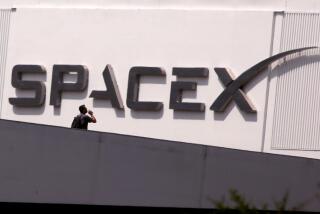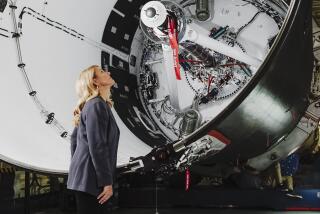Motor Maker Took Off With Space Shots
- Share via
Call Schaeffer Magnetics the Maytag of the space industry: Its spacecraft motors are known for dependability.
The Schaeffer Magnetics motors that control the telescope on Pioneer 10, the Jupiter probe launched in 1972, are a case in point. Twelve years after the craft was expected to burn out, it still is hurtling outside of the solar system, and its telescope is working fine.
“No one’s about to repair those motors if they malfunction,” said Ernie Schaeffer, 61, the Chatsworth company’s president and founder, who gets misty-eyed talking about space exploration. “Our products have to be good enough to work for a long, long time.”
‘Workhorses of the Industry’
Schaeffer Magnetics, which had sales last year of $3.2 million, appears to be the only company that does nothing but make motors for use in space. More than 300 Schaeffer Magnetics motors have been used in the U. S. space program over the past 19 years, including equipment on the space shuttles, and most of the company’s earliest products still work.
Those products include a motor that operates a data-gathering recorder aboard Voyager 2, launched in 1977. The probe passed Uranus last month after cruising by Jupiter and Saturn. Another Schaeffer Magnetics motor is on Mars, aboard the Viking 2, which was shut down three years after it landed on the planet in 1976.
“Schaeffer motors are the workhorses of the industry,” said Louis A. Watts, former Pioneer program manager for Hughes Aircraft’s research center in Santa Barbara. “They’re durable. But at the same time, they’re very delicately balanced.”
Nevertheless, the company’s clients--prime contractors such as Sperry, Lockheed and RCA--often make similar motors themselves.
Simple jobs are often cheaper to do in-house, explained Mike Jacobs, who works in the purchasing department for Martin Marietta in Denver. But, he said, when his company needs motors able to endure the most extreme conditions, it always calls Schaeffer Magnetics.
The business requires great expertise. The company had to master metals technology, Watts said, because it can’t use standard lubricants. Oil, for example, would evaporate in space.
High-Tech Look
Parts for the company’s motors are made from titanium and aluminum. The motors come in an assortment of shapes and sizes, depending on the specifications for the job, but all have a solid, high-tech look that resembles brushed chrome.
Schaeffer said testing the equipment for its capacity to withstand extreme conditions is the most crucial step in development. To simulate a space environment, the company uses thermal vacuum chambers that generate temperatures as cold as minus 150 degrees Fahrenheit and as hot as 300 degrees.
The company is preparing engineering models for the so-called tethered satellite, a craft being developed by the United States and Italy that space shuttles would hold with a 60-mile-long cable. The project’s goal is to perform scientific experiments at altitudes of less than 100 miles above Earth--a zone that satellites can’t fly in independently without tumbling out of orbit and crashing. Schaeffer Magnetics is designing the motor that will reel the cable in and out.
Designing and making the motors that move spacecraft parts have been the company’s mission since it was founded in the spare bedroom of Schaeffer’s Woodland Hills home in 1967, when he left an engineering job he held for eight years with Whittaker Corp. in Chatsworth.
Business was rocky in the early years, Schaeffer said, and he lost money. In June, 1969, the month before Apollo 11 took men to the moon for the first time, USM Corp., then an expanding technology firm in Boston, acquired a 51% interest in Schaeffer Magnetics.
Sole Owners
By 1971, Schaeffer Magnetics, as a subsidiary, became profitable, and it has been ever since. Schaeffer and his wife, Lulu, bought back the company in 1975, and they remain the sole owners.
Schaeffer Magnetics employs 40 people, mostly in manufacturing. The company’s sales have grown over the past five years at about 15% annually, Schaeffer said.
Like other parts suppliers for space projects, Schaeffer Magnetics must complete its contracts years before its products fly.
The company already has delivered $3 million in motors--its biggest project ever--to control lenses and solar panels for NASA’s Space Telescope.
This telescope, intended to help earthbound astronomers avoid the problems of bad weather, daylight and city lights, originally was scheduled for launch from the shuttle at the end of this year, but was postponed indefinitely because of the Jan. 28 explosion of the Challenger.
On the morning of the explosion, Schaeffer said, the company ceased operations for 30 minutes, accepting no phone calls, so workers could mourn silently.
The company made motors for Challenger’s tape recorders as well as equipment used on a satellite stored in the shuttle’s cargo bay.
Schaeffer said he isn’t worried by reports that the space program’s survival could be jeopardized by the accident. “Space is my life,” said Schaeffer, whose Mercedes convertible has license plates that read, US SPACE.
“We’re in space to stay, and anyone who doubts it just has his head in the sand,” Schaeffer said.
More to Read
Inside the business of entertainment
The Wide Shot brings you news, analysis and insights on everything from streaming wars to production — and what it all means for the future.
You may occasionally receive promotional content from the Los Angeles Times.










